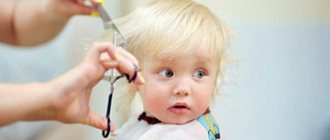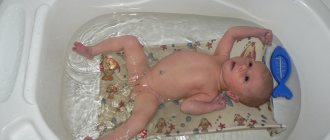Newborn first examination at the clinic. Over the course of a month, your baby has grown and become stronger. He should add at least 400g. and grow about 3cm.
He focuses his gaze on a stationary object. Begins to smoothly follow a moving object. Listens to her mother's voice, begins to smile when she sees her or hears her mother's voice. The child’s movements are still just as erratic, but he already raises and holds his head while lying on his stomach.
Screening
An ultrasound of the brain is recommended for all children at 1 month in order to promptly identify abnormalities in the functioning of the child’s central nervous system. The first examination is screening. That is, it is carried out for all children. In the future, ultrasound examinations for children are performed as prescribed by a neurologist.
Ultrasound of the hip joints (also recommended for all children). Helps to identify such a serious abnormality as congenital hip dislocation and treat the child in the first year of life. If a child is diagnosed with hip dysplasia (delayed formation of the heads of the femur), the mother will be explained how to do gymnastics and massage for the child.
Ultrasound of the abdominal organs and kidneys can detect congenital anomalies in the development of these organs. The most common diagnoses given to children using abdominal ultrasound are: hepatomegaly (enlarged liver), splenomegaly (enlarged spleen). This may not mean anything special, but requires further ultrasound monitoring of the child. Children with this diagnosis are referred to a gastroenterologist. Those children whose kidney ultrasound shows abnormalities are referred to a nephrologist.
Audio screening - Your baby's hearing is tested in the hospital. But, if for some reason it was not carried out in the maternity hospital, or your child has a questionable result, you will be offered to examine the child at the clinic.
It will be more convenient for you and your baby to undergo ultrasound and audio screening before visiting the doctors. So that they can evaluate the results of the examination.
How to prepare for the first visit to the clinic with a newborn?
Well, the first month of the baby’s life has flown by unnoticed, and it’s time to visit the children’s clinic for the first time with the newborn. How to prepare for this important event? During the first 30 days after birth, the baby is almost accustomed to a certain pattern of sleep, feeding, walks and other daily procedures. You have also studied your child quite well, so you can guess how the child will behave during the day. Don’t forget that you should visit the clinic with your newborn only on healthy baby days (or so-called “infant days”). On other days, a crowd of sneezing and coughing babies usually forms in the children's clinic, and it is not at all advisable for a healthy one-month-old baby to be in the same room with them. Prepare in advance everything you might need at the clinic. Here is a list of the most necessary things: - a large flannel diaper, - 2-3 disposable diapers, - wet wipes, - a bottle of formula or your own expressed milk (if you are not embarrassed to feed your baby outside the home, you don’t have to express milk), - a pacifier ( if the child is used to it), - a rattle (to distract the baby if he cries at the doctor's appointment), - spare underwear (just in case). — documents: baby’s insurance policy, your passport (may be needed) and all examinations and test results of the baby that you have in your hands. For example: a neurosonogram that could have been done on the child in the maternity hospital. - a small notebook and pen (you may need it to immediately write down any important information for you). - as well as some money (you may need to buy something at the pharmacy, for example: shoe covers or medicine for the baby that the doctor will prescribe for him). A baby monitor, which you can no longer do without, as you understand, will not be needed in the clinic. When you dress your baby, keep in mind that at the doctor’s appointment you will need to quickly undress the child and then dress him. And if you have the opportunity to show your baby to several more specialists on the same day, the procedure of undressing and dressing the baby will be repeated several times. The best clothing option for such an occasion is a bodysuit with fasteners between the baby’s legs and a jumpsuit with buttons. This outfit is very easy to take off and put on, and in addition, you can quickly change the diaper without completely undressing the newborn. It is best if there is a person with you at the clinic who is ready to help you: hold the baby, clothes, bag, etc. Perhaps there is no place in your clinic where you can safely leave a baby stroller, then you can leave an accompanying person to look after the cybex stroller and entrust him with all the outerwear, while you go with your child to the doctor’s office. If you are unable to find an assistant and your clinic does not have space to leave a stroller there, a sling scarf or a kangaroo backpack will help you out, since you can carry your baby in it from birth. As for public transport, in the first months of a toddler’s life it is advisable not to use it at all. Firstly, by using public transport, you increase the risk of your child contracting ARVI or other similar diseases. Secondly, after your baby is vaccinated, you need to minimize the risk of contracting any disease, and using public transport this is almost impossible. Thirdly, traveling on public transport with an infant is completely inconvenient. If the clinic is located far enough from your home and you do not have your own car, try to look for friends who have one and who can take you and your child to the doctor. Also in this case, you can call a taxi. At an appointment with your local pediatrician, you will be given referrals to specialists: a neurologist, an orthopedist, an ENT specialist, an ophthalmologist, a rheumatologist and a surgeon. They will also recommend doing an ultrasound of the hip joints (to rule out dysplasia), a neurosonogram (if you didn’t get one in the maternity hospital) and an ultrasound of the abdominal organs and kidneys. It is advisable to undergo all specialists and examinations as quickly as possible. After all, it is better to quickly check the child for the presence of various pathologies and rule them out than to find out about any disease when it has already begun to progress. At the first appointment, the doctor will listen to the baby’s lungs and heart, measure the fontanelle, head volume, chest volume and height, examine the umbilical wound and the scar from the BCG vaccination, and also weigh the baby. When the baby starts crying, try to distract him with a rattle or give him a bottle of milk. When communicating with the doctor, do not forget to tell him about everything that worries you in the baby’s behavior, as well as ask him all the questions that interest you. In order not to get confused at a doctor’s appointment, it is better to write all important questions in advance in a notebook and take it with you to the clinic. Listen carefully to all the doctor’s recommendations and do not rush to argue with him if his advice does not coincide with your own opinion. In the end, if you think the doctor’s recommendations are incorrect, no one is stopping you from showing your child to another specialist. After the examination is over (and provided that the baby is healthy), the doctor will ask you to go with the baby to the treatment room and get vaccinated (second vaccination against viral hepatitis B). Whether to vaccinate your toddler or not is your individual choice. Therefore, before making this important decision, carefully weigh the pros and cons. After visiting the treatment room, you can safely go home. This completes your first visit to the children's clinic.What to take with you to the clinic?
Two diapers. One is on the changing table. The other is on the scales. Sanitary napkins, a rattle, a pacifier (if your child is used to it), a spare diaper, and a bottle of water in the summer.
Vaccination certificate.
Examination results (ultrasound, audio screening).
And, of course, a notebook with your questions. It would be a good idea to write down the doctor's recommendations and your child's characteristics there. You will end up with something like your mother's diary.
First appointment with the pediatrician
The first visit to the doctor involves a thorough examination of the baby and a detailed questioning.
How the visit takes place:
- You undress the baby completely on the changing table in the office.
- The pediatrician examines the skin and mucous membranes, checks how the fontanel is healing, listens to the child’s heart and lungs, palpates the tummy, checks the hip joints - spreads the baby’s bent legs to the sides, checks the grasping reflex and how the baby focuses his gaze, checks whether the baby has neurological problems : Hypertonicity, chin trembling, etc. are common.
- The doctor will definitely ask you about your daily routine, the condition of the baby’s stool, the frequency and volume of feedings.
- Then the baby is weighed, the height and volume of the head and tummy are measured.
All this information will allow the doctor to assess how the child is developing and make recommendations if necessary.
If you have any doubts or concerns, be sure to ask.
Newborn first examination in the clinic examinations by doctors
At the clinic you will be examined by a pediatrician, neurologist, ophthalmologist, surgeon and vaccinated against viral hepatitis B.
You need to make an appointment with a neurologist, ophthalmologist, and surgeon in advance.
- An ophthalmologist identifies congenital and inflammatory diseases of the eye and lacrimal ducts. The most common is congenital dacryocystitis. Obstruction of the nasolacrimal duct and inflammation of the lacrimal sac. And also conjunctivitis. If necessary, prescribes treatment. The ophthalmologist also reveals changes in the fundus of the eye, which also reflects the state of the child’s central nervous system. A neurologist will definitely pay attention to this.
- The neurologist will examine the child, check reflexes, and measure the circumference of the head and chest. Evaluate the results of ultrasound of the head and fundus examination. And, if necessary, prescribe treatment for your child.
- The surgeon will check to see if the child has hernias, and will examine the external genitalia of boys. He will give his recommendations.
- An orthopedist will check the condition of the musculoskeletal system to rule out congenital diseases. For example, clubfoot, hip dislocation. This is where ultrasound results are needed.
What should mom wear?
In any case, the clothes, and most importantly the shoes, were comfortable and did not restrict movement.
If you are breastfeeding, you should dress so that you can feed your baby. Ideally, this is special clothing for feeding, but you can get by with regular clothes - take a large scarf with you or use a diaper to protect yourself from prying eyes.
In general, every clinic has a mother and child room where you can feed the baby, but, firstly, you may miss your turn or it may be closed altogether. Therefore, prepare for the fact that you will have to feed directly in the corridor.
And if you have to go to the clinic with a newborn in the cold season, before going out, first dress yourself, and then collect the baby - otherwise he may sweat in a warm suit and envelope.
Emergency hospitalization
Unfortunately, most unpleasant incidents with children occur in the evening or at night on weekends. Adults are running around the apartment in a panic, trying to figure out what might be needed in the hospital in the near future. To avoid such situations, there is a simple rule. Make a small list of things you need in case of emergency hospitalization and keep it handy. If such a situation does arise, the collection procedure will be significantly speeded up and will take no more than 10 minutes.
When taking your child to the hospital by ambulance, in the emergency room, do not forget to find out what the rules are for returning books and toys brought with you from home. Otherwise, the loss of a bear or doll can become a real tragedy for the baby. Indeed, in some departments (especially those related to intestinal and other infections), toys, which can only be rubber, as well as books, are not returned. An exception to the general rule are virus departments where acute respiratory infections are treated. If something happens, you can always leave the same toys in the storage room along with your outerwear.
Time of receipt
Sometimes doctors schedule appointments themselves. If you have a choice, the following recommendations will be useful for you:
- Choose a time to go to the clinic so that it falls between your baby’s sleep periods.
Then he will be well-rested, but not yet tired; - If admission is based on coupons, sign up first or second.
At the beginning of the day the queue is always smaller and you won't have to wait long; - If you were only given a time range that is common to everyone, then come in the middle of the appointment
. Everyone will want to come to the beginning, and you will sit in line for a long time; - The best time to take is morning
. No one wants to go straight from a warm bed to the clinic, so the line is shorter in the morning; - On some days, the pediatrician sees healthy children, and on others, sick children
. If you don’t want to come in vain and catch an infection, ask the reception desk in advance when they accept healthy babies; - If there was a quarantine in the clinic, then immediately after it there will be many visitors and long queues.
Therefore, if there is no special need, reschedule your visit to the pediatrician for one or two weeks.
As a rule, every clinic has a so-called infant day. This is a day (for example, Tuesday) during which all doctors work only with children under one year old. There is no need to queue up for an appointment on infant day using an electronic appointment - specialists accept patients on a first-come, first-served basis, but you need to find out better in advance. Some doctors try to admit newborns earlier than other infants, but this is at the discretion of the specialist.
How to make visiting the clinic easier
The first visit to the pediatrician is stressful for both the baby and the mother, especially if the child is the first and you don’t know how everything is organized and how to behave.
What can you do to make your visit easier:
- If possible, bring another adult to the clinic to help. Carrying a baby, running around offices or to the reception desk is easier if you have someone to replace you.
- Make sure that the baby's clothes are easily removable - in clinics they often open windows for ventilation, so it is important that the baby does not sweat and is not exposed to air.
- Don’t forget that in addition to you, there are many sick children in the clinic with various viruses, of course, on infant day there are fewer of them than usual, but still make sure that the baby does not touch the mattress and the side of the changing table with his face, be sure to wash a fallen toy or pacifier (or better yet, give give your baby a spare one, and remove the dirty one and wash it at home). Just in case, smear your baby's nose with oxolinic ointment. Lately there have been doubts about the effectiveness of its use, but in any case it won’t hurt.
- Take care of your nerves - in the clinic there are a lot of people who want to quickly get into the office, and the phrase “I’m just asking” is familiar to everyone who has ever been to our medical institutions. Therefore, try to be calmer about what is happening. Still, as a rule, on “baby day” the parents in line behave quite adequately.
- Remember that there are categories of children who can be examined without a queue.
Prepare for your visit to a medical facility in advance. Go to the doctor in a good mood, try not to be nervous or angry, because your mood is transmitted to the baby.
Follow the recommendations given in the article, look for additional information about how the first visit goes, and what the pediatrician is interested in. Prepare everything you need and your first visit to the pediatrician will go without problems. Then you will decide for yourself what is best to take with you, what is not necessary, and what time is best for your visit.
The first trip to the clinic with a newborn is a difficult task. But we will simplify it for you. We will tell you when it is better to come to the doctor so as not to wait long for your turn. We will also remind you what things you need to take with you.
The baby is growing very quickly. Only a month has passed since his birth, but the doctor no longer comes to the house himself. The time has come for the first trip to the clinic, and not just to the pediatrician, but for a whole medical examination (visiting several doctors). And such trips will have to be made every month (monthly to the pediatrician and some specialists). Later, you will begin to feel confident in the clinic, like at home. But the first time can make you nervous. What do you need to consider? I'll tell you about this in detail.











